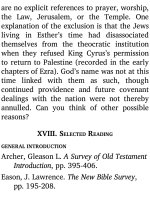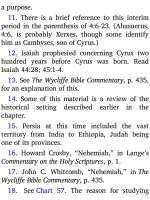Jensens survey of the old testament adam 161
Bạn đang xem bản rút gọn của tài liệu. Xem và tải ngay bản đầy đủ của tài liệu tại đây (117.98 KB, 4 trang )
the historical psalms. References to
historical
events
appear
frequently
throughout the book of Psalms.
3. Hallelujah. (E.g., Psalms 106,111-13,
115-17, 135, 146-50.) The theme of praise
in these psalms is obvious.
4.
Penitential.
(E.g.,
Psalms
6,32,38,51,102,130,143.) Confession of sin
occupies the greater part of each of these.
Psalm 51 is the classic example of this type
of psalm.
5. Supplication. (E.g., Psalm 86.) The
psalmist cries to God in his own need, or he
intercedes for another’s need.
6. Thanksgiving. (E.g., Psalms 16,18.) The
note of praise and thanksgiving pervades the
whole book of Psalms, but some individual
psalms are particularly thanksgiving psalms.
7. Messianic. (E.g., Psalms 2, 20-24,
41,68,118.) There is a strong prophetic
character of the Psalms. Many of the hymns
prophesy the su ering and sorrows of God’s
people, Israel, and their coming deliverance,
restoration, and blessing in a future glorious
Kingdom. But, most of all, they prophesy of
Christ in His two advents: His rst advent in
humiliation, and His second advent in glory.
Such psalms are called Messianic psalms.
Some of the Old Testament’s most minute
prophecies of Christ are found here. They
are about His person (God and man); His
character (righteous and holy); His work
(death and resurrection); and His o ces
(priest, judge, and king).
8.
Nature.
(E.g.,
Psalms
8,19,29,33,65,104.) God’s handiwork is an
inspiring subject for any poetical writing.
9. Pilgrim. (E.g., Psalms 120-34.) This
group of psalms, each bearing the title
“Song of Degrees,” was probably a
hymnbook used by the Jews on their
pilgrimage up to the Temple on the
occasions of the national feasts.
10.
Imprecatory.
(E.g.,
Psalms
35,52,58,59,69,83,109,137,140.)
The
imprecatory (cursing) passages of these
psalms are generally looked upon with a
great deal of perplexity. Many cannot
understand how such utterances could be
acceptable to God. The problem is answered
when one recognizes the age and the setting
of their writing. Gleason L. Archer writes:
It is important to realize that prior to
the rst advent of Christ, the only
tangible way in which the truth of the
Scripture could be demonstrated to
human observers was by the pragmatic
test of disaster befalling those who
were in error and deliverance being
granted to those who held to the truth.
As long as the wicked continued to
triumph, their prosperity seemed to
refute the holiness and sovereignty of
the God of Israel. A Hebrew believer in
the Old Testament age could only
chafe in deep a iction of soul as long
as such a state of a airs continued.
Identifying himself completely with
God’s cause, he could only regard
God’s enemies as his own, and implore
God to uphold His own honor and
justify Hisown righteousness by
in icting a crushing destruction upon
those who either in theory or in
practice denied His sovereignty and
His law.5
III. SURVEY
1. Study the survey Chart 70, and observe
that the 150 psalms are divided into ve
groups. These divisions date back to ancient
times. We do not know the original reasons
for identifying groups as such. Some think









